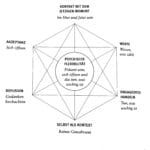Driving can feel like navigating a chaotic maze, but with the right tools, you can transform into a confident, proactive driver. One such tool is the SIPDE method. This five-step process isn’t just a helpful acronym; it’s a roadmap to safer driving. So, what does SIPDE stand for? It’s your personal driving assistant, guiding you through Scan, Identify, Predict, Decide, and Execute. Let’s dive into each step, empowering you to anticipate and avoid potential hazards on the road. Unleash the electrifying power of pikachu tg05 tg30 and discover a world of shocking surprises!
Decoding SIPDE: Your 5 Steps to Safer Streets
This section breaks down each element of SIPDE, providing practical advice and examples to enhance your driving skills.
Scan: Broaden Your View
Imagine reading with tunnel vision – you’d miss the majority of the story. Similarly, effective scanning means looking beyond the car directly in front of you. Aim for a visual lead of 20-30 seconds, which translates to about a block or two in city driving and further on highways. Look for changes in traffic flow, upcoming intersections, merging lanes, and anything that could disrupt the smooth flow of traffic. This proactive scanning gives you a head start, buying precious time to react to developing situations. Current research suggests that this proactive approach greatly reduces accident probability.
Identify: Spotting Potential Hazards
Bring your focus closer, within a 12-15 second range, and identify potential hazards. This might be a pedestrian near the curb, a cyclist maneuvering through traffic, a car signaling a turn, or even road debris. Anything that could pose a problem warrants your attention at this stage.
Predict: Anticipating the Unexpected
Predicting is where you put your judgment into action. What might those identified hazards do next? Will the pedestrian step into the street? Could the turning car brake suddenly? This mental preparation, anticipating the worst-case scenario however unlikely, can drastically improve your reaction time if a hazardous situation develops.
Decide: Charting Your Course
Once you’ve predicted potential outcomes, it’s time to decide on the safest course of action. Should you adjust your speed, change lanes, tap your brakes to warn trailing drivers, or honk your horn? Having a plan before a problem arises transforms you from a reactive to a proactive driver, giving you greater control in challenging situations.
Execute: Smooth and Controlled Responses
The final step is to smoothly execute your chosen maneuver. This could involve gently braking, carefully steering into a different lane, or simply maintaining a safe following distance. Practice makes perfect; the more you consciously apply SIPDE, the smoother and more instinctive your actions will become.
SIPDE in Action: Real-World Examples
How does SIPDE play out in real driving situations? Consider these scenarios:
| Scenario | Scan | Identify | Predict | Decide | Execute |
|---|---|---|---|---|---|
| Approaching an intersection | Traffic light turning yellow | Car approaching quickly | Car might run the red light | Slow down and prepare to stop | Gently apply brakes |
| Highway Driving | Traffic slowing in the distance | Brake lights ahead | Possible accident or congestion ahead | Change lanes | Signal and carefully merge into next lane |
| Residential Street | Child playing near the curb | Child near the road | Child might run into the street | Slow down significantly | Cover brake, steer away from the curb |
Essential Elements of Safe Driving with SIPDE
Beyond the five steps, several factors contribute to effective SIPDE application:
Following Distance: Your Safety Buffer
Tailgating significantly limits your ability to use SIPDE effectively. A safe following distance, often described as the “two-second rule,” gives you the time and space to react if the driver ahead brakes abruptly.
Visual Skills: Enhancing Your Awareness
Good vision is crucial for safe driving. Regular eye checkups are important, and maintaining a clean windshield drastically improves visibility. Even minor impairments can hinder your ability to scan and identify hazards.
SIPDE’s Impact on Driver Safety
While SIPDE can be helpful for passing driving tests, its true value lies in improving driver safety. Some researchers suggest a strong correlation between consistent SIPDE application and a reduced likelihood of accidents. There’s ongoing research exploring the precise relationship between SIPDE training and accident rates, but early indications are promising. This suggests that integrating SIPDE into your driving becomes a lifelong habit that significantly enhances your safety on the road. It’s not just about memorizing steps; it’s about developing a proactive mindset that keeps you engaged with your surroundings.
Why SIPDE Matters: Beyond the Test
SIPDE isn’t just for passing your driver’s test; it’s a powerful tool for everyday driving. By consistently applying these five steps, you’ll not only become a safer driver but also a more confident and aware one. While the specific benefits of SIPDE are still being studied, many experts believe it plays a crucial role in accident prevention. Remember, the road is a dynamic environment, and SIPDE equips you with the skills needed to navigate its complexities safely and efficiently.
FAQ: Common Questions about SIPDE
Here are answers to some frequently asked questions about SIPDE:
What are the 5 steps of SIPDE?
SIPDE stands for Search, Identify, Predict, Decide, and Execute.
When should I use SIPDE?
You should use SIPDE constantly while driving – from the moment you start your car until you reach your destination. It’s a continuous cycle that keeps you aware and prepared.
Why is following distance important in SIPDE?
A safe following distance gives you the time and space needed to react effectively to unexpected events, allowing you to execute the “Decide” and “Execute” steps of SIPDE.
How can I improve my SIPDE skills?
Conscious practice is key. Make a deliberate effort to apply SIPDE every time you drive. Over time, it will become second nature.
Is SIPDE only for new drivers?
No, SIPDE is beneficial for drivers of all experience levels. It’s a valuable tool for maintaining safe driving habits throughout your driving career.
- Kilby Correctional Facility (Alabama): Inmate Search, Visitation, Contact Info, and More - December 18, 2024
- Ancient Mesopotamia: Beyond the NYT Crossword Clue - December 18, 2024
- Osamu Dazai’s Schoolgirl: A Poignant Glimpse into 1939 Tokyo - December 18, 2024















